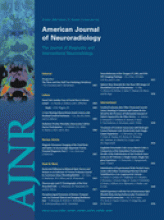An impressive review of the “many faces” of facial schwannoma was recently presented by Wiggins III et al.1 After such nearly definitive research, it may be deceitful to collect other anecdotal data, but we would like to know the authors’ opinion about our single observation. “Dural tail” sign, a common but not specific feature of meningioma, can be observed, as recently reviewed by Guermazi et al,2 in several conditions, including glioma, brain metastasis, acoustic schwannoma, lymphoma, adenoid cystic carcinoma, sarcoidosis, and aneurysms. We are not, however, acquainted with other facial schwannomas featuring the dural tail in radiologic literature.
We report a case of a man, aged 44 years, referred to CT/MR imaging for a 6-month progressive right-sided hypoacusia, audiometrically proved to be a mixed hearing loss. No facial nerve paresis was found.
CT (Fig 1) showed a soft-tissue mass extending from the geniculate fossa to the attic, resulting in lateral displacement of the malleus and incus. The internal auditory canal was flared, and the labyrinthine segment of the fallopian canal was enlarged. Bony structures were remodeled, with no aggressive features.
On MR images, a bilobed inhomogeneous enhancing mass was depicted, involving the cerebellopontine angle cistern, the internal auditory canal, and the labyrinthine and geniculate portion of the facial nerve, protruding into the middle cranial fossa (Fig 2). On coronal planes (Fig 3), a short but clear dural tail sign was observed.
Following a transmastoid route, the mass was approached and a partial dissection was obtained to avoid an iatrogenic facial palsy. The patient is scheduled for MR imaging follow-up.
Although the pathologic explanation for the dural tail is, to date, questionable (tumoral extension, connective proliferation, hypervascularity, vascular dilation, and so forth), the article by Wiggins III et al1 reminds us that there is no question about the lack of specificity of this sign.
CT, axial (A) and coronal (B) planes: Internal auditory canal is flared, labyrinthine portion of facial canal enlarged (lance) and geniculate fossa expanded (arrowheads) by a soft tissue mass (star) protruding posteriorly into the epitympanum, where ossicles are laterally displaced but normally shaped.
MR post-gadolinium SE T1 axial plane: extra-axial bilobed enhancing mass, involving the right cerebellopontine angle cistern (star), internal auditory canal (not shown on this plane), labyrinthine (arrowhead) and geniculate portion (arrow) of the facial nerve. In this not fat-saturated pulse sequence the mass blurs with marrow in the petrous apex (lance).
MR post-gadolinium SE T1 coronal plane: a short dural tail is depicted along the tentorium (arrow).
References
- Copyright © American Society of Neuroradiology















